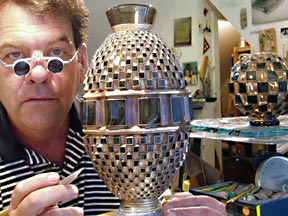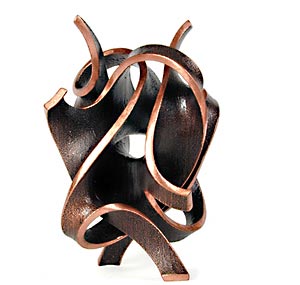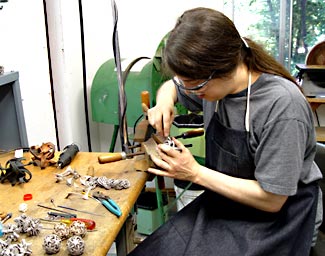Artists and Alchemists: The Art of Copper Electroforming
 Periodic Equilibrium, 2005, by Michael Glancy Blown glass with cut lenses, deeply engraved (radiation cut), blue and clear industrial plate glass base plates, copper, and silver
Periodic Equilibrium, 2005, by Michael Glancy Blown glass with cut lenses, deeply engraved (radiation cut), blue and clear industrial plate glass base plates, copper, and silver Photograph by Gene Dwiggins
Electroforming, the intricate process of fusing copper onto another medium where a low voltage charge is passed through the materials to create a relief that becomes a separate part in its own right, allows artists to create thicker copper structures layered over other materials like glass or wax. This form, unlike electroplating, creates a totally new layer and is actually a science, a method that reflects the best copper use in art. Thomas Edison used electroforming in his work, as did Michael Faraday, a famous 19th Century physicist and chemist. It was exotic, it was costly, and in the early days, was used to reproduce art pieces. This technique is still fairly exotic, but as a scientific process was discovered in 1810, by the father of electroforming, Professor Moritz von Jacobi in the Academy of Science, in St. Petersburg, Russia.
"According to Stanley Lechtzin, he had the Czar's committee review the patent at the Czar's Academy, and they were so impressed that they presented him with a large monetary award of 25,000 silver Rubles," says Michael Glancy, a renowned glass and copper artist, who resides in Massachusetts and exhibits his electroformed pieces worldwide. "After that, the Academy published an article and presented it to the world as a free gift."
 Artist Michael Glancy at work in his studio
Artist Michael Glancy at work in his studioPhotograph Gene Dwiggins
In the ancient world, a metalsmith would associate planets with various metals. Copper was associated with the planet, Venus, because of its importance to them, according to Glancy. There's a hierarchy of metals within the periodic chart and most metal artists are familiar with this structure.
"For example, you don't want to put copper next to iron because you'll create a battery, and if you want to put copper onto iron, you must place nickel on first, then layer the copper over the nickel and iron - or it will exchange ions and create a battery," says Glancy. (Editorial note: this process is also known as galvanic corrosion) "This corrodes the metal, so it's imperative that metal workers know about these sequences. When layering metals, it's done strictly with under-coats so the physics of it should always work. The Greeks made it more romantic by associating it with the planets. But, people have marveled at copper's strength and malleability to format. Personally, I'm attracted to its ability to be patinated and the amazing way it achieves colors on the metal. I work in gold and silver, too, but mainly copper."
Glancy received his B.F.A. from the University of Denver, a B.F.A and M.F.A.. at the Rhode Island School of Design, where he's now an Associate Faculty Member in the jewelry and metalsmithing department. His work is available at Barry Friedman LTD, in New York, among other places.
"I studied under Dale Chihuly, a famous sculptor who primarily uses glass as a medium," he explains. "I was a glass sculptor major, but decided to take classes in metal. In the metals department was a room with a primitive metal electroforming tank, much like a liquid bath. I didn't know what it was, and someone told me it was called electroforming. At that time, my work included integrating metal powders and oxide into molten glass, but I quickly realized that by electroforming I could apply a copper skin to the piece as well."
Glancy uses electroforming as a tool and method to apply copper on his work with a process that includes a chemical bath using bars of copper. He obtains his copper from a U.S. supplier, Technic, Inc. He's familiar with the history of electroforming, and states that its modern application using electricity in a chemical environment in its early day was fascinating to scientists and inventors. His own pieces are inspired from microscopic landscapes and more, but are centered in scientific and philosophical concepts, and viewed all over the world. His work is represented in many public and private collections, including the Metropolitan Museum of Art, New York, the Glasmuseet Ebeltoft, Denmark, Musee des Arts Decoratifs, Paris, Museum of Contemporary Art, Hokkaido, Japan, Victoria and Albert Museum, London, and many others.
Kate Fowle Meleney, who resides in Rhode Island, has been working in metals since the late 1980's, doing enameling on copper using electroforming. Her main genre is creating glass beads, which she then electroforms with copper.
 Artist Kate Fowle Meleney in her studio, painting a glass bead with conductive copper paint to attract copper ions from the solution before she electroforms the piece.
Artist Kate Fowle Meleney in her studio, painting a glass bead with conductive copper paint to attract copper ions from the solution before she electroforms the piece. Photograph by Barbara Newman
"I was lured to the transition from metal to glass because I was using antique trade beads with metal charms created from copper and silver," she says. "When I learned how to work in metal, I always used copper before using silver, because you can be more spontaneous and more creative when using copper. When I worked in metal, I purchased it from Rio Grande, a jewelry distributor, but now, when electroforming, I purchase whole sheets of roofing copper from a hardware store. I used to collect old glass beads and used them in my jewelry. In 1990, at the Second International Bead Conference, someone was demonstrating glass bead making. I took a class, thinking it would be adjunct to my metal work, and shortly left metal work in the dust. When I began creating glass beads, in 1991, I knew how to electroform. The first bead I electroformed was in 1991, and I was the first person to electroform on a glass bead. I know that other people were doing it on glass, but I was the first to do it on a lampworked bead. However, the beads were so simple that the metal didn't enhance them, so I began doing vessels and urns. Those were the first beads that I thought looked like a copper surface would be quite fitting and compliment them. That's when I began the vessels and developed my Goddess and a line of beads that appear ancient."
 Fowle Meleney torching a glass bead, in her studio
Fowle Meleney torching a glass bead, in her studio Photograph by Isis Ray
Fowle's Goddess is wearing an electroformed copper necklace with a green patina. Now, she's a production piece, and Kate enjoys creating it.
"I love electroforming with copper for many reasons, but especially the color it gets from patinas," she explains. "If I were doing electroforming in another metal I'd give it a dull patina so it would look like copper anyway. Also, copper electroforming uses a sulphuric acid-based solution, and silver and gold use a cyanide-based solution, which isn't safe.
Her copper pieces, especially those in her new Biotech Series, is where she feels her design and technical abilities have culminated. She's creating something that is sculptural, wearable, combs her interest in surface treatments, along with her technical ability to electroform. She has also included other materials besides glass, but the glass forms are inspired by nature then are enclosed in an electroformed skin to add contrast.
"People can check out my Web site to see some of my pieces, but my Green Hydra, a pendant that is lampworked glass with copper and silver leaf, is electroformed copper with liver of sulfur patina," she explains. "The Red Hydra is also electroformed, and the end pieces on both the Green and Red Hydra is a silicone bead, kind of like a rubber bead, and on many of these beads I used minute, small glass balls to add texture in the electroforming. Right now, I'm still working on the Biotech Series, but I change the beads continually. I'm focusing on pendants and also free style beads. Beads are what I do - either loose beads that collectors collect, as well as my series of vessels and urns."
 Bathsheba Grossman's Electroformed Antipot
Bathsheba Grossman's Electroformed Antipot Photograph courtesy of Bathsheba Grossman
Fowles teaches all over the U.S. and Europe, and was in Japan this past October for a lampworking festival. She's taught in Australia and is returning to Denmark this year to teach for five days. She's also been the featured artist in Ornament Magazine, Glass Art, and the featured artist in one of a series of books written by Jim Kervin, The Enamel and Electroform Decorated Beads of Kate Fowle Meleney.
"People buy my work when I teach and I'm involved in several large shows a year," she says. "I'll be teaching electroforming to everyone at the Bead and Button Show in Milwaukee, Wisconsin in June (2008). I love to teach and will continue, but this year I'm focusing on more experiments in my studio. One thing I would like to begin doing is some enameling on electroformed copper. I enjoy the teaching aspect as much as working alone in my studio. In fact, I feel like the Pied Piper of glass as I still teach beginning classes and it's the best fun I've ever had."
The ancient art form of electroforming is also used by artist Bathsheba Grossman, who explores the region between art and mathematics with three-dimensional metal sculpture. She received a degree in mathematics from Yale, then took art studies at the University of Pennsylvania.
 Bathsheba Grossman in her studio
Bathsheba Grossman in her studio Photograph courtesy of Bathsheba Grossman
She studied sculptural principles and metalworking with Erwin Hauer and Robert Engman, mathematical sculptors who were trained by Josef Albers. Her work has been seen on the television series Numb3rs and Heroes, and featured in several publications, including The New York Times and Wired. Grossman designs artwork for subsurface laser etching in glass and has created a line of scientific images based on astronomy, molecular biology and mathematics, as well as a service for imaging protein structures used by major pharmaceutical companies and research centers. She designs for 3D printing in metal, which is part of her business as well as glass etching, as well as electroforming.
"I've done a few pieces in electroforming," she explains. "My work is very involuted and it's difficult to get a uniform coating. I have a piece called Antipot where electroforming with copper was successful. It was coated with approximately a millimeter of copper, and the piece is strong, light and durable. The metal is solid and nonporous, and the copper patinates easily with moderate heat."
Resources:
Also in this Issue:
- Artists and Alchemists: The Art of Copper Electroforming
- Copper Artist Burt Squires Revives the Historic Barn Star
- Martino Hoss and Pastel on Copper: Vignettes of a Memory
- Honoring the Bronze Bas Relief at the Base of Provincetown's Pilgrim Monument
- New Gallery for Native North American Art Opens at Metropolitan Museum, Rare Copper Mask on Display
